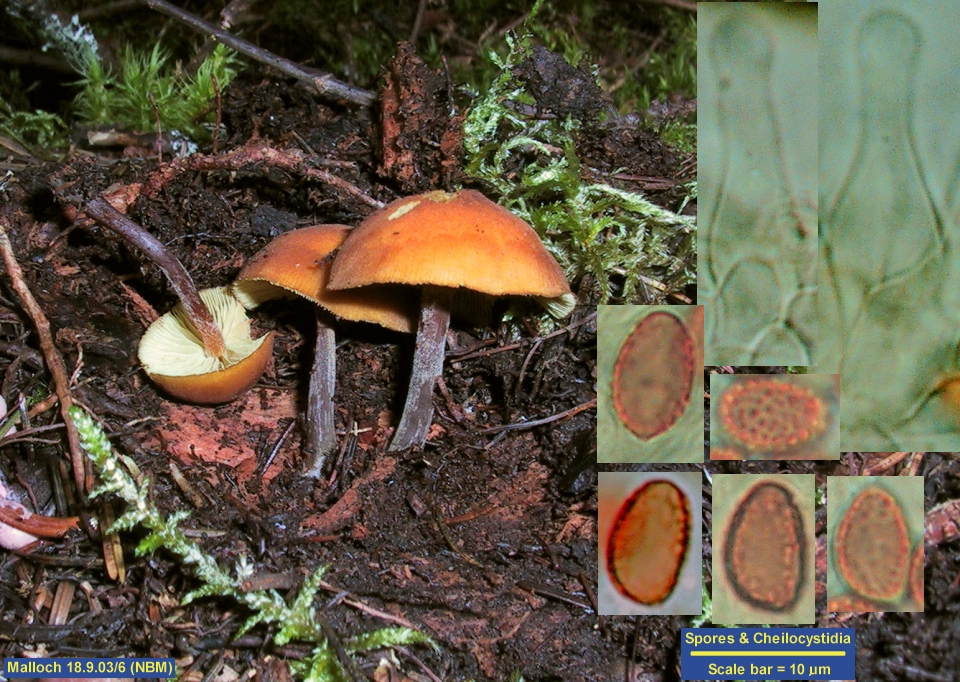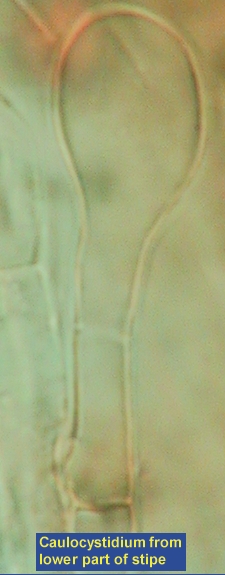Fleshy Fungi of New Brunswick >>
Gymnopilus picreus
A Focus on Species >>
Gymnopilus picreus
Gymnopilus picreus (Pers.:Fr.) Karsten

Gymnopilus picreus is not a well-understood species. It has been interpreted in a variety of ways in the modern literature so that the name may well be in use for more than one species. The concept applied to the New Brunswick material is of a species with a reddish brown smooth pileus and a dark brown to nearly black stipe covered by a white "bloom" or pruinosity due to clusters of caulocystidia. The lamellae and flesh are yellow and have a very bitter taste. This interpretation is in agreement with Kühner and Romagnesi's (Flore Analytique, 1953) discussion of Fries' concept, which stresses the dark and entirely pruinose stipe.
There are several photographs representing G. picreus in the mycological literature, but most are not convincingly the same species as ours. The one in Moser and Jülich's Farbatlas has entirely orange basidiomata with stipes that are not at all dark. Breitenbach and Krönzlin's Fungi of Switzerland, Volume 5, is more similar to ours than Moser and Jülich's but again the stipe is not as dark and lacks the white pruinose "frosting". Pomerleau (Flore des champignons au Quebec) reports G. picreus from Quebec but illustrates a collection with ventricose non-capitate cheilocystidia quite unlike those in our collection. The best fit was with a French collection illustrated on a web page of B. Bacyk, unfortunately no longer online. Gymnopilus picreus is included on the list of a mycological survey made by Agriculture Canada in Kouchibouguac National Park. I have not seen this material but it is represented by a voucher specimen in the National Mycological Herbarium in Ottawa (DAOM).
Technical Description

PILEUS convex, without an Ámbo or only faintly so, glabrous, moist, Greyish orange to Brownish orange (Kornerup and Wanscher 5BC6), Light brown (6D5) in the marginal 5 mm, 18-27 mm in diameter. STIPE fairly equal, dry finely white-pruinose througout its length, Dark brown (7F5) except for the Brownish orange (6C3-4) apex, 30-33 X 2-4 mm. LAMELLAE Pale yellow to Light yellow (4A3-4), close, adnexed, not marginate. FLESH Pale yellow (4A3) in the pileus and concolorous with the surface tissues in the stipe, lacking a distinctive odour, with a very bitter taste.
PILIEPELLIS composed of repent and parallel, encrusted, clamped hyphae 6-11 μm in diameter. TRAMAL HYPHAE thick-walled in KOH. CHEILOCYSTIDIA ventricose-capitate, 20-34 X 6-10 μm. PLEUROCYSTIDIA infrequent, similar in size and shape to the cheilocystidia. CAULOCYSTIDIA produced in clusters throughout the length of the stipe, similar to the cheilocystidia at the stipe apex but becoming more clavate or balloon-like toward its base. PILOCYSTIDIA not seen. BASIDIOSPORES ellipsoidal, coarsely roughened, 8.0-9.1 X 5.0-6.0 μm.
Photo: D Malloch